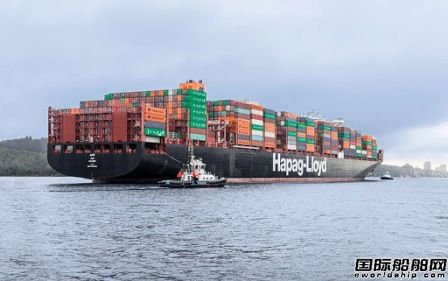
Current LocationïžHome - News - Industry

|
|||
| Publishedïž2021.04.12 News SourcesïžQingdao Gute Ship Supplies Co., Ltd. Viewsïž | |||
|
A world first! China Resources Dadong completed the dual fuel refit project for very large container ships


The Sajir, now renamed Brussels Express, left China Resources Dadong on April 3 and is on its way to the South Korean port of Busan, Hapelot confirmed. The ship will gradually resume operations and be redeployed on the Asian/Nordic trade routes. The entire conversion project is expected to cost about $35 million. It is understood that "Sajir" arrived at China Resources Dadong Terminal 7 on August 31 last year, ready to install LNG dual fuel tanks, and the refit project officially started on September 2. The 6,500-cubic metre Mark III LNG storage tank designed by French engineering firm GTT has been installed on board, and the heavy-fuel (HFO) MAN B&W 9S90ME-C engine has been converted to a dual-fuel MAN B&W ME-GI engine. The Sajir is one of 17 container ships in the Haprot fleet that were originally designed to be LNG-ready, designed to be able to easily modify LNG bunker tanks and associated piping systems to use LNG as fuel. In early 2019, Herberot signed a contract with Hudong China for the refit of the Sajir. China Resources Dadong will be responsible for the refit, while German engineering company Technolog will provide the overall refit design. Sajir is the world's first large ship to be fitted with LNG dual fuel tanks. The total section of the LNG dual fuel tank is 13 meters long, 46 meters wide and 21.6 meters high. It is composed of 17 sections, among which the section size of the DS01 dome base is 6 meters long and 5 meters wide. The main difficulty lies in the subsection production and the precision control of the overall group, which requires very high. This is the world's first single shell to double hull ship, the world's first container ships longer widened, and the domestic initiative for the operation of LNG ship equipped with floating regasification module, CRC cable to create another first in the world, and fully shows the company in the field of "combination" ship repair and modification of continuous innovation, constantly breakthroughs, continuously exceed strong strength. With dual-fuel refits, Hapelot hopes it will be able to reduce the environmental impact of large ships. With LNG power, the Sajir can almost completely (more than 90 percent) eliminate sulfur emissions from exhaust gas and diesel particulate emissions, and reduce nitrogen oxide and carbon dioxide emissions by about a third. 
However, Hapelot is likely to shelve plans to convert the Sajir's remaining 16 sister ships. Late last year, Habben Jansen pointed out that LNG-based retrofit is a very expensive job, with the Sajir retrofit project costing $35 million. "We will not be able to recoup this investment in the life of the ship," he said. This means that Sajir's conversion will be a unique pilot project due to its high price, and no other ships in the Hapelot fleet will undergo similar LNG-powered conversion. At the time, Habben Jansen said that to be commercially viable, the cost of retrofitting would have to fall below $25 million, which is $10 million less than current costs. "We need to find ways to reduce costs, otherwise it will be very difficult from an economic point of view to convert more ships," he said. It's a good pilot project, but we may not be able to continue. We are still looking for ways to reduce costs." While abandoning LNG-powered retrofitting for the time being, Hapelot will continue to look for ways to reduce carbon dioxide emissions from its ships. Habben Jansen said that the company will redouble its efforts to reduce its environmental footprint, and that it will begin to develop a new plan for the next three to five years, with the goal of becoming climate neutral within the next 30 years and reducing emissions to zero by 2050 at the latest. Late last year, Heberot placed an order for six LNG-powered 23500TEU VLCSs from Daewoo Shipbuilding in South Korea. The new vessels, which will be delivered in succession between April and December 2023, are equipped with energy-efficient high-pressure dual-fuel engines that can operate on LNG but also have enough tank capacity to run on conventional fuel. |
|||
| This Paper Is Divided Into 1 Page | |||
| Next:Another 12? CAFI will return to China to order LNG - powered 10,000-container ships | |||
| Previous:Annual profit of $2.6 billion! Yangtze River shipping industry "epidemic" ahead | |||







